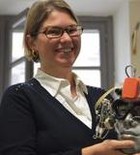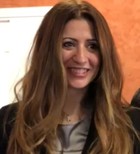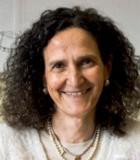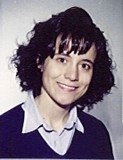Risultati: 12

Funzione/Ruolo
Professoressa ordinaria di Ingegneria informatica al Politecnico di Torino e direttrice dell’Hub AI@polito
Percorso professionale
Si laurea in Fisica nel 1998 all'Università La Sapienza di Roma, proseguendo la sua formazione con un Master in Biomedical Signal and Image Processing. Il suo percorso di ricerca continua all'estero, prima presso l'Università di Erlangen-Norimberga, poi presso l'Istituto di ricerca Smith-Kettlewell Eye a San Francisco e al Royal Institute of Technology (KTH) di Stoccolma, dove consegue il dottorato di ricerca in Informatica nel 2005. Barbara Caputo si trasferisce in Svizzera per lavorare all'Istituto di ricerca Idiap a Martigny e in seguito diventa responsabile del gruppo di ricerca sui sistemi cognitivi artificiali dello stesso Istituto Idiap. Tornata in Italia, nel 2013 è professoressa associata del Dipartimento di Ingegneria informatica automatica e gestionale all'Università La Sapienza di Roma. Oggi è professoressa ordinaria di Ingegneria informatica al Politecnico di Torino e senior researcher all'Istituto Italiano di Tecnologia.
Risultati scientifici
Il principale interesse di ricerca di Barbara Caputo, definita dai media "la donna che parla con i robot", è lo sviluppo di algoritmi per l'apprendimento, il riconoscimento e la categorizzazione di modelli visivi e multimodali per sistemi autonomi artificiali, come appunto i robot. Alla guida del gruppo di ingegneria robotica Visual Learning and Multimodal Perception (VALEM) dal 2013, Barbara Caputo, con i suoi colleghi, sta sviluppando degli algoritmi per permettere ai robot di apprendere le informazioni direttamente da internet. Sarà così possibile creare dei robot capaci di apprendere ma anche di interagire e reagire agli imprevisti con una vasta possibilità di impieghi, dalla home robotica all'assistenza di anziani, disabili e bambini.
Attività editoriali e pubblicazioni
Barbara Caputo è autrice di diverse pubblicazioni su riviste internazionali, fra cui:
(2016) Kuzborskij I, Orabona F, Caputo B. Scalable Greedy Algorithms for Transfer Learning. Computer Vision and Image Understanding, arXiv:1408.1292.
(2015) Atzori M, Gijsberts A, Kuzborskij I, Caputo B, et al. Characterization of a Benchmark Database for Myoelectric Movement Classification.IEEE Transactions on Neural Systems and Rehabilitation Engineering, 23(1):73-83.
(2014) Castellini C, Artemiadis P, Wininger M, Caputo B, et al. Proceedings of the first workshop on Peripheral Machine Interfaces: Going beyond traditional surface electromyography. Frontiers in Neurorobotics, 8:22.
(2014) Gijsberts A, Bohra R, Sierra Gonzalez D, Caputo B, et al. Stable Myoelectric Control of a Hand Prosthesis using Non-Linear Incremental Learning.Frontiers in Neurorobotics, 25:8.
(2014) Tommasi T, Orabona F, Caputo B. Learning Categories From Few Examples With Multi Model Knowledge Transfer. The IEEE Transactions on Pattern Analysis and Machine Intelligence, 36(5):928-41.
(2013) Gijsberts A, Caputo B. Exploiting accelerometers to improve movement classification for prosthetics.IEEE International Conference on Rehabilitative Robotics, 2013:6650476.
(2012) Atzori M, Gijsberts A, Heynen S, Hager AG, Castellimi C, Caputo B, Müller H.Experiences in the creation of an electromyography database to help hand amputated persons. Studies in Health Technology and Informatics,180:828-32.
Riconoscimenti e premi
Nel 2014 Barbara Caputo si è aggiudicata il prestigioso Starting Grant dell'European Research Council (ERC) per il progetto "RoboExNovo Robots learning about objects from externalized knowledge sources". Lo Starting Grant è un riconoscimento che premia i nuovi talenti della ricerca mondiale che si impegnano a costruire il loro laboratorio in un paese Europeo.

Funzione/Ruolo
Professoressa ordinaria di Ingegneria informatica e Direttrice del Dipartimento di Ingegneria informatica, automatica e gestionale dell'Università La Sapienza di Roma.
Percorso professionale
Dopo aver conseguito la laurea in Ingegneria Elettronica all'Università La Sapienza di Roma nel 1987, prosegue la sua formazione con un dottorato in Informatica nella stessa università. Dal novembre 2000 è professoressa ordinaria di Sistemi di Elaborazione delle Informazioni presso la Facoltà di Ingegneria Informatica, Informatica e Statistica della Università la Sapienza di Roma. Dal 2009 all'ottobre 2014 è presidente del Centro InfoSapienza. Dal novembre 2010 all'aprile 2014 è prorettrice per le Infrastrutture e le Tecnologie e coordinatrice dell'Organismo di Indirizzo e Raccordo (OIR) della stessa università. Dal 2014 è direttrice del Centro Interuniversitario sull'Elaborazione Cognitiva in Sistemi Naturali e Artificiali (ECONA). Dal maggio 2015 è direttrice del centro interdipartimentale di ricerca "Sapienza Design Research". Dal luglio 2015 è presidente di KION S.p.A., una azienda appartenente al gruppo CINECA. Dal 2018 è Direttrice del Dipartimento di Ingegneria informatica, automatica e gestionale dell'Università La Sapienza di Roma.
La professoressa Catarci è molto attiva nella lotta contro le disparità di genere e nella promozione delle discipline STEM tra le studentesse, promuovendo progetti dedicati sia a livello scolastico che universitario e fungendo da modello per "Inspiring Girls" e altre iniziative.
Risultati scientifici
L'attività di ricerca di Tiziana Catarci si concentra sin dai suoi esordi sull'interazione persona-calcolatore, fornendo uno tra i primi e più significativi contributi a livello internazionale relativamente alle tematiche di interazione utente e usabilità applicate al settore delle basi di dati. Avendo iniziato a lavorare in questa area alla fine degli anni Ottanta, quando i sistemi interattivi erano agli esordi, Tiziana Catarci e il suo gruppo hanno di recente ripreso, sviluppato e reso attuali molti dei risultati di quegli anni, ora che l'usabilità, e più in generale la "user experience" sono tra le caratteristiche essenziali della cosiddetta "smart interaction". Rimanendo nell'ambito applicativo delle basi di dati, Tiziana Catarci, consapevole che con lo sviluppo e la diffusione di Internet sempre un maggior numero di utenti avrebbe iniziato a interagire con una enorme quantità di informazioni spesso disomogenee e destrutturate, ha sviluppato nuove interfacce che permettono di reperire, integrare e manipolare dati multimediali provenienti da fonti diverse in modo che tutto sia accessibile anche a chi, tra gli utenti, non possiede particolari conoscenze tecniche. Nella sua attività di ricerca Tiziana Catarci si è anche interessata a problematiche specifiche delle basi di dati, quali la modellazione e interrogazione di sorgenti eterogenee, su cui ha ottenuto interessanti risultati, e, recentemente, alla qualità dei dati, che costituisce oggi una tematica fortemente innovativa e di cruciale importanza per i moderni sistemi informativi e la società digitale.
Attività editoriali e pubblicazioni
Tiziana Catarci fa parte del Comitato scientifico e svolge attività di revisione per molte importanti riviste scientifiche e conferenze internazionali dei settori di interesse, incluse ACM Transactions on Computer-Human Interaction, ACM Transactions on Information Systems, VLDB Journal, IEEE Transactions on Knowledge and Data Engineering, WWW Journal, Journal of Visual Languages and Computing, ACM Interact, Computing Surveys, VLDB, ACM Sigmod, IEEE Multimedia, ACM CHI.
È autrice di oltre 200 articoli scientifici su riviste internazionali, fra cui:
(2014) Bauleo E, Carnevale S, Catarci T, Kimani S, Leva M, Mecella M. Design, realization and user evaluation of the SmartVortex Visual Query System for accessing data streams in industrial engineering applications. Journal of Visual Languages and Computing 25(5):577-601.
(2010) Catarci T, Dix AJ, Kimani S, Santucci G. User-Centered Data Management. Morgan & Claypool Publishers.
(2010) Bianchini D, Montanelli S, Catarci T, et al. Emergent Semantics and Cooperation in Multi-knowledge Communities: the ESTEEM Approach. World Wide Web Journal, 13(1):3-31.
(2008) Catarci T, et al. Pervasive Software Environments for Supporting Disaster Responses. IEEE Internet Computing, 12(1):26-37.
(2006) Czerwinski M, Gage DW, Gemmell J, Marshall CC, Pérez-Quiñones MA, Skeels MM, Catarci T. Digital memories in an era of ubiquitous computing and abundant storage. Communications of the ACM, 49(1):44-50.
(2003) Mecella M, Scannapieco M, Virgillito A, Baldoni R, Catarci T, Batini C. Managing Data Quality in Cooperative Information Systems. Journal on Data Semantics (LNCS subline, Springer), 1:208-232.
(2000) Catarci T. What Happened When Database Researchers Met Usability. Information Systems, 25(3):177-212.
(1997) Catarci T, Costabile MF, Levialdi S, Batini C. Visual Query Systems for Databases: A Survey. Journal of Visual Languages and Computing, 8(2), 215-260.
(1993) Catarci T, Lenzerini M. Representing and Using Interschema Knowledge in Cooperative Information Systems. Journal of Intelligent and Cooperative Information Systems, 2(4):375-398.
(1990) Angelaccio M, Catarci T, Santucci G. QBD: A Graphical Query Language with Recursion. IEEE Transactions on Software Engineering, 16(10):1150-1163.
Riconoscimenti e premi
Nel 2003 vince l'IBM Eclipse Innovation Award per il progetto SEAWER, SEmantic Annotation of WEb Resources.
Nel 2014 è la prima candidata donna alla carica di Rettore nella secolare storia della Università la Sapienza.
Nel 2015 riceve l'onorificenza di Commendatore della Repubblica Italiana.
Nel 2016, è invitata a far parte della prestigiosa European Academy of Sciences and Arts.
Nel 2021 vince il premio internazionale "Le Tecnovisionarie".

Funzione/Ruolo
Corporate Social Responsibility Country Manager IBM Italia e IBM Master Inventor
Percorso professionale
Laureata in Scienze dell’Informazione all’Università di Bari. Vince una borsa di studio al CNR di Genova per la sezione informatica. Trascorre due anni di ricerca presso il CORINTO (Consorzio di Ricerca Nazionale per Tecnologia ad Oggetti) a Bari. Subito dopo inizia a lavorare per l’IBM, dove ricopre diversi ruoli in differenti settori, ma rimanendo sempre nella realizzazione di progetti digitali innovativi. Riveste il ruolo di dirigente per IBM e IBM Italia della Responsabilità Sociale di Impresa.
Nel 2016 viene selezionata dal Commissario per l’attuazione all’agenda digitale per il Governo italiano, Diego Piacentini, ed entra a far parte del Team per la Trasformazione Digitale per la Presidenza del consiglio. Per ricoprire il ruolo di Esperto Digitale richiede ed ottiene l’aspettativa da IBM. Da Febbraio 2019 è la nuova Direttrice di Fondazione IBM ed anche Corporate Citizenship manager per l’Italia. Floriana dal 2008 è stata insignita della nomina di Master Inventor, nel suo curriculum 21 brevetti nel campo digitale. Leader per Italia di progetti NERD? Non è Roba per Donne? a P-Tech.
Risultati scientifici
Floriana Filomena Ferrara è autrice di 21 brevetti nell’ambito dell’innovazione digitale.
Digital-entusiasta, ama condividere la sua passione soprattutto con le studentesse delle scuole superiori puntando ad incoraggiare le giovani donne ad intraprendere studi nel campo STEM. Diversi i progetti che la vedono protagonista, il principale è il progetto “NERD? - Non È Roba per Donne?”, nato da una collaborazione tra IBM e la professoressa Paola Velardi della Sapienza . Il progetto al momento ha raggiunto 10.000 studentesse in Italia grazie alla collaborazione di 100 colleghe/amiche volontarie della Fondazione IBM e alla disponibilità di scuole e Università sparse per tutta l’Italia. In dettaglio le Univerisità coinvolte sono: Bicocca Milano, Università Alessandria e Vercelli, Università di Genova, Università di Padova, Federico II Napoli, Politecnico di Bari e Università di Bari.
Attività editoriali e pubblicazioni
[2000-2018] #61 Publication in IBM Tech Disclosure Bulletin
[1997] Ferrara, Corinto & Aphrodite a new Object Oriented methodology. SEDBT, CNR.
[1996] Ferrara, Clematis, Cassano, Spagnulo. Peucher&Douglass for the Processing Terrain with characterisation on "Triangolazione", “Rapporto Tecnico”, IMA 14/95.
[1996] Cassano, Clematis, Ferrara, Spagnulo, Network based parallel processing for terrain characterisation on irregular simple data. “High-Performance Computing and Networking”, HPCN Europe 1996: 940-941.
Riconoscimenti e premi
2008-2019 Master inventor https://en.wikipedia.org/wiki/IBM_Master_Inventor
2015, Una delle 100 donne che contano nel Digitale http://www.chefuturo.it/2015/08/100-donne-digitali-italia/
2016, One of the 100 woman in the Digital in Italy http://startupitalia.eu/67126-20161229-le-100-donne-nel-digitale-del-2016
2017, one of 15 influential Italian women in the world of digital technology, technology and innovation of https://www.digitalic.it/economia-digitale/donne-influenti-digitale-italia-digiwomen-2017
2017, When the innovation is woman: 150 women in Italy http://startupitalia.eu/76729-20170815-150-profili-al-femminile-da-seguire-su-innovazione-startup-e-digitale
2018, Premio Eccellenze Joniche 2018 http://www.eccellenzejoniche.it/
2018, Le 150 donne che contano nel digitale https://startupitalia.eu/95739-20180815-le-150-donne-da-seguire-in-italia-su-startup-innovazione-e-digitale
2019, Role model per Sistema Scuola-Impresa http://www.elis.org/aiutiamo-i-ragazzi-realizzare-i-loro-sogni
2019, Premio donna dell’anno per l’Innovazione, della rivista D la Repubblica delle donne

Funzione/Ruolo
Professoressa ordinaria di Informatica presso l'Università dell'Insubria di Varese
Percorso professionale
Dopo aver conseguito la laurea in Informatica all'Università di Milano nel 1992, prosegue la sua formazione attraverso un dottorato di ricerca in Informatica presso la stessa università nel 1998. Durante l'estate del 1996 svolge un periodo di ricerca come visiting researcher al Dipartimento di Informatica della George Mason University di Fairfax in Virginia, nei due anni successivi è visiting researcher presso la Rutgers University di Newark, in New Jersey. Nel 1998 torna in Italia e ricopre il ruolo di assistente alla docenza di Informatica presso l'Università di Milano. Successivamente diventa professoressa ordinaria di Informatica dell'Università dell'Insubria di Varese.
Risultati scientifici
Le sue attività di ricerca sono legate ai vari aspetti dei sistemi di gestione dei dati, compresa la sicurezza del web, il controllo degli accessi e la privacy. Recentemente è stata impegnata in diversi progetti di ricerca come "ISocial" che sviluppa sistemi evoluti per la protezione della privacy nelle reti sociali. Ha lavorato al progetto della UE Euforbia, che prevedeva una serie di esperimenti sul filtraggio dei documenti in Internet secondo un approccio imparziale. L'obiettivo era produrre un nuovo sistema di esame delle informazioni più potente e flessibile, in grado di adattarsi alle esigenze culturali di ogni utilizzatore. Questo sistema è capace di operare una selezione in base al contenuto semantico delle informazioni, e si adatta alla descrizione degli argomenti presenti in un determinato sito web. Attualmente di occupa di problematiche di sicurezza e privacy in ambito IoT (Internet of Things) e Big Data.
Attività editoriali e pubblicazioni
È autrice di numerose pubblicazioni fra cui:
(2015) N. Laleh, B. Carminati, E. Ferrari. Risk Assessment in Social Networks based on User Anomalous Behaviour. IEEE Transactions on Dependable and Secure Computing, 15(2):295-308.
(2015) P. Colombo, E. Ferrari. Privacy aware access control for Big Data: a research roadmap. Big Data Research, 2(4).
(2014) Akcora C, Carminati B, Ferrari E, Kantarcioglu M. Detecting Anomalies in Social Network Data Consumption. Social Network Analysis Mining, 4(1):231.
(2014) Parra-Arnau J, Perego A, Ferrari E, Fornè J & Rebollo-Monedero D. Privacy-Preserving Enhanced Collaborative Tagging. IEEE Transactions on Knowledge and Data Engineering, 26(1):180-193.
(2013) Carminati B, Ferrari E, Viviani M. Security and Trust in Online Social Networks, Synthesis Lectures on Information Security, Privacy and Trust. Morgan & Claypool.
(2011) Cao J, Carminati B, Ferrari E, Tan KL. CASTLE: Continuously Anonymizing Data Streams. IEEE Transactions on Dependable and Secure Computing, 8(3): 337-352.
(2010) Bonchi F, Ferrari E. Privacy-Aware Knowledge Discovery: Novel Applications an
Articoli in atti di congressi internazionali:
(2016) Carminati B, Colombo P, Ferrari E & Sagirlar G. Enhancing User Control on Personal Data Usage in Internet of Things Ecosystems. Proceedings of the 13th IEEE International Conference on Services Computing, San Francisco, USA.
(2016) Colombo P & Ferrari E. Towards Virtual Private NoSQL Datastores. Proceedings of the32nd IEEE International Conference on Data Engineering, Helsinki, Finlandia.
(2014) Bahri L, Carminati B, Ferrari E. Community-based Identity Validation on Online Social Networks. Proceedings of the 34th International Conference on Distributed Computing Systems Madrid, Spagna.
Riconoscimenti e premi
Per le sue ricerche nel campo della privacy e della sicurezza, Elena Ferrari è stata premiata nel 2009 da una delle due più importanti associazioni internazionali di riferimento (IEEE - Institute of Electrical and Electronic Engineers) con il Technical Achievement Award. Nel 2011 ha ottenuto il Google Research Award per le sue ricerche nel campo della privacy nelle reti sociali mentre nel 2014, ha ottenuto l'IBM Faculty Award per le sue ricerche sulla privacy dei big data. E' IEEE fellow e ACM (Association for Computing Machinery) Distinguished Scientist.

Funzione/Ruolo
Rettrice del Gran Sasso Science Institute (GSSI).
Percorso professionale
Nel 1981 consegue la Laurea in Scienze dell'Informazione all'Università di Pisa. Nello stesso anno entra a far parte della Olivetti con il ruolo di ricercatrice che mantiene anche durante il decennio 1984-1994 presso il CRN di Pisa. Nel 1994 consegue la docenza ordinaria di informatica all'Università dell'Aquila, dove successivamente ricopre diversi ruoli di prestigio nella governance universitaria: dal 1994 al 2000 è Presidente del corso di Laurea di Informatica e successivamente Direttrice del Dipartimento di Informatica. Nel 2008 diventa Preside della Facoltà di Scienze Matematiche, Fisiche e Naturali della stessa università. Dal luglio 2012 al settembre 2013 dirige il Dipartimento di Ingegneria e Scienze dell'Informazione e Matematica (DISIM). Paola Inverardi nell'anno accademico 2013/2014 viene eletta Rettrice dell'Università dell'Aquila, carica che manterrà fino al 31 ottobre 2019. Nel 2022 si trasferisce al Gran Sasso Science Institute, Istituto di Studi Superiori in Matematica, Fisica, Informatica e Scienze sociali, ricoprendo la carica di Rettrice.
Risultati scientifici
I suoi interessi principali riguardano l'ingegneria del software, con particolare attenzione all'area delle architetture software, che includono, oltre all'organizzazione della struttura del sistema stesso, le modalità con cui le diverse parti si integrano e interagiscono a formare un tutt'uno. In tale ambito si è occupata di analisi e verifica di proprietà architetturali sia comportamentali che quantitative per sistemi basati su componenti, distribuiti e mobili. È inoltre attivamente impegnata nella collaborazione con importanti industrie del settore delle tecnologie dell'informazione e delle telecomunicazioni. Svolge regolarmente l'attività di revisora per agenzie internazionali della ricerca e università estere e per la Commissione Europea.
Attività editoriali e pubblicazioni
Autrice di numerose pubblicazioni nazionali ed internazionali fra cui:
2011) Cortellessa V, Di Marco A, Inverardi P. Model-Based Software Performance Analysis. Springer 2011, isbn 978-3-642-13620-7.
(2009) Pelliccione P, Inverardi P, Muccini H. CHARMY: A Framework for Designing and Verifying Architectural Specifications. IEEE Transactions on Software Engineering, 35(3):325-346.
(2004) Balsamo S, Di Marco A, Inverardi P, Simeoni M, Model-Based Performance Prediction in Software Development: A Survey. IEEE Transactions on Software Engineering, 30(5):295-310.
(2004) Muccini H, Bertolino A, Inverardi P, Using Software Architecture for Code Testing. IEEE Transactions on Software Engineering, 30(3):160-171.
(2003) Inverardi P, Tivoli M, Deadlock-free software architectures for COM/DCOM Applications. Journal of Systems and Software, 65(3):173-183.
(2001) F Aquilani, S Balsamo, P Inverardi: Performance analysis at the software architectural design level. Performance Evaluation, 45(2):147-178.
(2000) Inverardi P, Wolf AL, Yankelevich D, Static checking of system behaviors using derived component assumptions. ACM Transactions on Software Engineering and Methodology, 9 (3), 239-272.
(1995) Inverardi P, Nesi M, Deciding observational congruence of finite-state CCS expressions by rewriting Theoretical Computer. Science, 139(1):315-354.
(1995) Inverardi P, Wolf AL, Formal specification and analysis of software architectures using the chemical abstract machine model. IEEE transactions on Software Engineering, 21(4):373-386.
(1993) Inverardi P, Mazzanti F, Experimenting with Dynamic Linking with Ada. Software: Practice and Experience, 23(1):1-14.
Riconoscimenti e premi
A maggio 2011 ha ricevuto un dottorato onorario dalla Mälardalen University in Svezia; nel 2013, il IEEE TCSE Distinguished Service Award "for outstanding and sustained contributions to software engineering community". Inoltre Paola Inverardi è componente di ACM Europe Council e di Academia Europaea.

Funzione/Ruolo
Professoressa ordinaria di Bioingeneria industriale all'Istituto di BioRobotica della Scuola Superiore Sant'Anna di Pisa e Professoressa alla National University di Singapore
Percorso professionale
Dopo aver conseguito la laurea in Informatica presso l'Università di Pisa nel 1993, prosegue la sua formazione attraverso un dottorato di ricerca in Robotica all'Università di Genova nel 1998. Dall'anno successivo è assegnista di ricerca e poi ricercatrice in Biorobotica alla Scuola Superiore Sant'Anna di Pisa. Dal 2001 al 2002 è anche visiting researcher al Humanoid Robotics Institute of Waseda University di Tokyo, Giappone. Dal 2006 è professoressa associata e dal 2014 ordinaria di Biorobotica alla Scuola Superiore Sant'Anna di Pisa. E' inoltre professoressa alla National University di Singapore, nel Dipartimento di Ingegneria Meccanica.
Risultati scientifici
L'interesse di ricerca di Cecilia Laschi è la BioRobotica. Partendo da un'esperienza in robotica di base, ha investigato soluzioni bio-ispirate per la robotica personale e di servizio. Recentemente ha lavorato a un progetto molto ambizioso che è cresciuto in un acquario del Centro di Ricerca per le Tecnologie del Mare e la Robotica Marina sulla costa di Livorno. A fare da modello vivente un vero e proprio polpo. Copiando il movimento del cefalopode, nel progetto europeo OCTOPUS, Cecilia Laschi e il suo team hanno posto le basi dello sviluppo della biomimetica del futuro: ossia la progettazione e la realizzazione di robot bioispirati, costruiti con materiali morbidi. Il primo prototipo di braccio robotico è stato costruito imitando la struttura muscolare del braccio del polpo con materiali siliconici, realizzando attuatori innovativi che permettono di ottenere una contrazione della struttura muscolare e realizzato con una copertura di contenimento del braccio, ispirata al tessuto connettivo del polpo, nonché una pelle artificiale dotata di ventose. Il braccio robotico funziona in acqua perché, come il polpo, sfrutta le caratteristiche meccaniche della interazione con l'acqua imitando la flessione e l'allungamento del braccio. Le tecnologie sviluppate imitando il polpo trovano ora ulteriore sviluppo in molti progetti che riguardano applicazioni che vanno dalle esplorazioni marine al settore biomedicale, in chirrgia e nell'assistenza agli anziani. Questa ricerca ha portato allo sviluppo della nuova area di ricerca della Robotica Soft, a livello internazionale. Al nome di Cecilia Laschi è legato anche un altro importante progetto: nel 2007 ha infatti contribuito fattivamente alla nascita, a Tokyo, del laboratorio congiunto di robotica "Robot-An" tra la Scuola Superiore Sant'Anna e la Waseda University dove ricercatori italiani e giapponesi svolgono insieme ricerca di frontiera. Grazie alle competenze della nostra nostra scienziata in robotica umanoide ha visto la luce I-Droid, prodotto da un'azienda spin-off da lei fondata, il primo personal robot venduto in dispense in otto paesi, capace di parlare, riconoscere ordini elementari, vedere, muovere la testa ad un rumore, simulare sentimenti ma soprattutto apprendere, memorizzando degli schemi di comportamento.
Laschi è anche tra gli inventori di un altro gioiello della robotica pisana: i DustBot, i robot-netturbini. Ossia DustClean, che pulisce le strade con spazzole e spray disinfettanti e DustCart, un "omino di neve" color verde, su due ruote che (previa telefonata o sms) si presenta davanti la porta di casa, spalanca il cassetto-pancia, riceve il sacchetto di rifiuti e lo porta fuori dal centro storico. I due Wall-e italiani - ai quali Laschi ha lavorato dal 2006 tramite la RoboTech - sono entrati già in servizio in via sperimentale in un paesino della Toscana.
Attività editoriali e pubblicazioni
Cecilia Laschi è autrice di numerose pubblicazioni su riviste scientifiche nazionali ed internazionali fra cui:
(2016) Laschi C, Mazzolai B. Lessons from nature: the symbiosis of morphological computation and soft robotics. IEEE Robotics & Automation Magazine 23.
(2016) Calisti M, Falotico E, Laschi C. Hopping on Uneven Terrains With an Underwater One-Legged Robot. IEEE Robotics and Automation Letters,1.1:461-468.
(2016) Cianchetti M, Laschi C. Pleasant to the Touch: By Emulating Nature, Scientists Hope to Find Innovative New Uses for Soft Robotics in Health-Care Technology. IEEE Pulse, 7(3):34-37.
(2016) Cauli N, Falotico E, Bernardino A, Santos-Victor J, Laschi C. Correcting for Changes: Expected Perception-Based Control for Reaching a Moving Target. IEEE Robotics and Automation Magazine, 23(1):63-70.
(2015) Cianchetti M, Calisti M, Margheri L, Kuba M, Laschi C. Bioinspired locomotion and grasping in water: the soft eight-arm OCTOPUS robot. Bioinspiration & Biomimetics, 10, 035003.
(2015) Renda F, Giorgio-Serchi F, Boyer F, Laschi C, Modelling cephalopod-inspired pulsed-jet locomotion for underwater soft robots. Bioinspiration and Biomimetics, 10(5).
(2015) Calisti M, Corucci F, Arienti A, Laschi C. Dynamics of underwater legged locomotion: Modeling and experiments on an octopus-inspired robot. Bioinspiration and Biomimetics, 10(4).
(2014) Renda F, Giorelli M, Calisti M, Cianchetti M, Laschi C. Dynamic Model of a Multibending Soft Robot Arm Driven by Cables. IEEE Transactions on Robotics, 30, 1109-1122.
(2014) Laschi C, Cianchetti M. Soft Robotics: New Perspectives for Robot Bodyware and Control. Frontiers in Bioengineering and Biotechnology, 2.
(2013) Kim S, Laschi C, Trimmer B. Soft robotics: a bioinspired evolution in robotics. Trends in Biotechnology, 31, 287-294.
La lista completa è disponibile online.
Riconoscimenti e premi
Co-fondatrice nel 2004 della società spin-off accademico della Scuola Superiore Sant'Anna "RoboTech srl", nel campo della robotica edutainment. Cecilia Laschi è co-autrice di sedici brevetti in Italia, Europa e Giappone.

Funzione/Ruolo
Chief Executive Officer di DAXO GROUP e DAXOLAB, Presidente DONNE 4.0 e Vicepresidente ARTES 4.0
Percorso professionale
Darya Majidi è un'imprenditrice digitale italo-iraniana, computer scientist, esperta in intelligenza artificiale, autrice, docente universitaria, attivista per i diritti umani e digitali e keynote speaker, pioniera e visionaria dell’Information Technology in Italia. Partecipa attivamente alla trasformazione digitale del nostro Paese da oltre 30 anni, con esperienze maturate in ambito pubblico, privato, accademico ed internazionale. Ha dato vita a startup e aziende innovative, vanta referenze di merge & acquisition tra le sue aziende e corporate internazionali ed esperienze di private equity e venture capital che l’hanno vista protagonista nella trasformazione di startup da lei create in aziende strutturate.
Attualmente è CEO, fondatrice e proprietaria della Daxo Group, società di consulenza strategica e di formazione di digital transformation che da oltre 10 anni accompagna i propri clienti prestigiosi nella loro trasformazione e formazione digitale con particolare attenzione all’empowerment digitale femminile in ottica di chiusura del digital gender gap. La Daxo Group è la prima azienda in Italia attestata con la ISO 30415 in ottica implementazione di politiche di Diversity & Inclusion.
CEO e owner di Daxolab, coworking, acceleratore e incubatore di imprese che ad oggi ha dato vita ad una ventina di startup innovative e ospita un eco sistema unico di professionisti, PMI e grandi aziende.
Founder e Presidente della Associazione Sociale Donne 4.0, supporta l’empowerment digitale delle ragazze e delle donne a livello nazionale e internazionale. Donne 4.0 rappresenta una associazione unica nel panorama internazionale nel coniugare le conoscenze e competenze tecnologiche e digitali con gli aspetti di etica e soft skills. Progetti da Majidi ideati e lanciati AIxGIRLS, AIxWOMEN, StartupHER.
Vice-Presidente del Centro di Competenza ARTES 4.0, capitanato dalla Scuola Superiore Sant’Anna di Pisa, supporta il trasferimento tecnologico tra imprese e università.
Speaker, docente, mentore, TEDx speaker e Member della Singularity University Faculty.
È stata Assessora all’Innovazione della città di Livorno, contribuendo a trasformare la città in una Smart City, creando sistemi e servizi per semplificare il rapporto tra la pubblica amministrazione con le imprese, i cittadini e gli ordini professionali. Le attività svolte hanno avuto numerosi riconoscimenti nazionali ed internazionali. È stata Presidente del Gruppo Giovani Imprenditori di Confindustria Livorno e Vice Presidente di Confindustria di Livorno con delega alla ricerca e all’innovazione.
Ha numerose collaborazioni con università di prestigio internazionali, tra i quali la Scuola Superiore Sant’Anna di Pisa, la Scuola Normale di Pisa, la Rome Business School ed altri.
È una mamma, una role model, una donna attiva che spera di impattare il mondo concretamente.
Attività editoriali e pubblicazioni
Darya Majidi. Donne 4.0. 2018.
Darya Majidi. Sorellanza digitale. Femminismo 4.0. 2020.
Riconoscimenti e premi
Nel 2021 è stata menzionata da D di Repubblica come una delle 100 donne che stanno cambiando il mondo e nel 2022 da Io Donna del Corriere della sera tra le 10 donne che impattano l’Italia.
Nell'ottobre del 2023 è stata riconosciuta tra le most powerful women del mondo da Fortune Italia, che le ha dedicato la copertina.

Funzione/Ruolo
Direttrice di Ricerca, Sviluppo e Strategia alla Medicaltech srl. Presidente emerita di Talent4Rise
Percorso professionale
Dopo la laurea in informatica, continua i suoi studi con una specializzazione in cibernetica / intelligenza artificiale e ingegneria dei sistemi elettronici. Dal 1989 è ricercatrice presso il Laboratorio Centrale di Ricerca di un'importante e innovativa azienda italiana di telecomunicazioni. Successivamente ha iniziato a contribuire ad alcuni comitati di standardizzazione internazionali, in particolare quello relativo al linguaggio VHDL. Dal 1993 è stata responsabile di progetti di R&S su aree relative a strumenti di automazione della sintesi logica, utilizzando sistemi esperti, reti neurali, logica fuzzy e coordinatrice di progetti, in ambito internazionale, per la ricerca e l'applicazione di algoritmi di codifica e decodifica video. Dal 2000 è stata responsabile di progetti di Multimedia Content Delivery e Architetture di rete. Nel 2013 ha coordinato attività relative alla telemedicina e al risparmio energetico per la smart city in collaborazione con Monzino e il Centro Cardiologico di Milano Ricerche. Nel 2014 ha vinto una selezione pubblica per titoli per una collaborazione con l'Università degli Studi di Milano presso il Dipartimento di Scienze Farmacologiche e Biomolecolari. Nel 2013 fonda, con un gruppo di colleghe, un'associazione di donne (Talent4Rise, che sotto la sua direzione diventerà socio fondatore della Fondazione Triulza, padiglione della società civile per EXPO2015). L'obiettivo è quello di dare visibilità ai talenti femminili STEM. Ha ricoperto la carica di presidente e membro del consiglio generale della Fondazione Triulza fino al 2016. Successivamente è stata nominata presidente emerita e vicepresidente e, nello stesso periodo, è stata nominata direttore del marketing strategico di un'azienda ICT. Dal 2014 è membro del Consiglio di Amministrazione di una società in house di un comune dell'hinterland milanese che raggruppa le farmacie locali.
Risultati scientifici
Da circa 30 anni Mirella Mastretti si occupa di aree innovative sia come ricercatrice e docente di alta formazione, sia come manager in contesti accademici, della società civile e di aziende ICT. Le sue attività hanno riguardato il coordinamento di progetti finanziati a livello nazionale e internazionale. Membro di comitati scientifici e di standardizzazione internazionali, ha contribuito alla definizione del linguaggio VHDL, all'implementazione di originali strumenti di sintesi logica (brevettati) e ad algoritmi innovativi per applicazioni audio/video, AI (Artificial Intelligence) e reti neurali.
Ha sempre gestito progetti e occasioni per vivacizzare il dibattito sull'innovazione in ambito sanitario e life-science, sul ruolo della scienza e della tecnologia nella società, con particolare attenzione a metodi, strumenti e tecnologie, per garantire una buona qualità di vita e assistenza a persone croniche o anziane e per la formazione inclusiva; il tutto si è svolto in un contesto di "sharing economy" che vede la collaborazione tra aziende, mondo accademico e terzo settore
Attività editoriali e pubblicazioni
[1990] Antoniazzi S., Mastretti M. An Interactive Environment for Hardware/Software System Design at the Specification Level. Microprocessing and Microprogramming, vol. 30.
[1991] Antoniazzi S., Mastretti M. An Architectural Design Support Environment for High-Performance Digital Systems. Microprocessing and Microprogramming, vol.32.
[1994 ]Balboni A., Mastretti M., Stefanoni M. Static Analysis of VHDL ModelEvaluation. Proceedings of EURO-VHDL.
[1995] Mastretti M., Sturlesi M. Tomasello S. Static Analysis of VHDL Code: Simulation Efficiency and Complexity. Proceedings VHDL: Champions of the Second Generation, San Diego, California.
[1995] Mastretti M., Sturlesi M. Tomasello S., Busi M., Sarvello R. VHDL Quality: Syhtnesizability, Complexity and Efficiency Evaluation. European Design Automation Conference with EURO-VHDL ’95, Brighton, September.
[1996] Mastretti M., Sturlesi M., Tomasello S. Quality Measures and Analysis: A Way to improve VHDL Models, Hardware Component Modeling. Kluwer Academic Publisher.
[1996] Mastretti M., Sturlesi M. Tomasello S., Busi M., Sarvello R. Static Analysis of VHDL Code: the SAVE project. Proceedings of 3rd International Conference on Achieving Quality in Software (AquIS’96).
[1996]Mastretti M. Current Issues in Electronic Modeling. Kluwer Academic Publisher.
[1998] Mastretti M., Paolillo E., Di Bello P., Mercandalli D. Technologies for the Information Society, Developments and Opportunities, IOS Press.
[1999] Boscolo M., Mastretti M., Paolillo E. Technology as the Catalyst of Users' Acceptance in Electronic Commerce. Flexible Working, New Network Technologies, pp. 121-132.
[2015] Mastretti M. Best Practices for EXPO2015, Tecniche Nuove.
[2016] Mastretti M. Impresa che funziona - come finanziare ricerca e innovazione con i fondi pubblici, Sandit.
Riconoscimenti e premi
Nel 1989 riceve il premio "Milano Ricerche".
Nel 2012 riceve il Premio "Progetto Regione Lombardia" (SURE-SMAU)
Nel 2014 riceve il "Premio Camera di Commercio di Milano", per il progetto Rise2Up
Nel 2015 è nominata "Digital champion", ambasciatrice dell’innovazione, da Riccardo Luna, su incarico del Presidente del Consiglio.
Nel 2016 è nominata Presidente emerita di Talent4Rise.

Funzione/Ruolo
Vice Presidente BT Security EMEA & APAC at BT
Percorso professionale
Laureata in informatica e matematica alla Bar-Ilan University di Tel Aviv, consegue successivamente un MBA in tecnologie e innovazione al Technion, l’Israel Institute of Technology di Haifa.
Dal 2003 al 2008 lavora in Avnet Information Security & Risk Managementm arrivando a ricoprire il ruolo di VP Products and Services. Nel 2008 lavora in Eurekify, con il ruolo di Vice Presidente EMEA (Europe, Middle East, Africa). Dal 2009 al 2015 è in CA Technogies, con il ruolo iniziale di Direttrice delle vendite EMEA e poi di Capo della Strategia per la sicurezza, sempre in area EMEA. Dal 2016 al 2018 è in HP, dove guida le attività ESS (Enterprise Security Services) in qualità di Responsabile per il Sud dell'area EMEA. Nel marzo 2018 approda in BT, dove guida un team pan-europeo di esperti di sicurezza che proteggono alcune delle più importanti e complesse organizzazioni a livello mondiale contro le sempre più crescenti minacce informatiche.
Risultati scientifici
Nel corso degli anni ha sviluppato significative esperienze nel campo della sicurezza informatica, sia in ambito militare che civile/commerciale, oltre a competenze ed esperienze cyber focalizzate a mitigare le crescenti minacce informatiche. E’ stata tra le prime esperte di sicurezza di sistemi ERP, seguendo in qualità di Security Advisor più di 30 progetti. Una significativa esperienza è stata inoltre maturata sul tema dell’Identity and Access Management, avendo contribuito attivamente alla creazione di una start-up poi acquisita da CA Technogies. In BT ha approfondito tematiche di Cyber Intelligence partecipando attivamente a gruppi di lavoro volti a sfruttare le potenzialità dell'intelligenza artificiale applicata alla Cyber Security.
Grazie alle esperienze e conoscenze maturate figura spesso tra i relatori delle principali conferenze e convegni del mondo sulla sicurezza informatica. Alcuni esempi: RSA conference di San Francisco, Kuppinger Cole EIC conference di Monaco, Cyberweek di Tel Aviv, Security summit di Milano e Forum PA di Roma.

Funzione/Ruolo
Professoressa ordinaria di Informatica presso l'Università La Sapienza di Roma
Percorso professionale
Dopo la laurea in Scienze dell'Informazione all'Università degli Studi di Roma La Sapienza nel 1993, prosegue la sua formazione con un dottorato di ricerca in Ingegneria Informatica conseguito presso la stessa università. Durante il dottorato è vincitrice di una prestigiosa borsa di studio Fulbright grazie alla quale nel 1996 è Visiting Research Associate presso l'Advanced Communications Technologies laboratory della Boston University, l'anno successivo presso la Erik Jonsson School of Engineering and Computer Science della University of Texas, a Dallas. Nel 1998, collabora con il Dipartimento di Elettronica e Informazione del Politecnico di Milano. Dall'anno successivo è assegnista di ricerca al Politecnico di Milano. Dall'anno successivo è assegnista di ricerca al Politecnico di Milano e svolge anche attività didattiche. Da 2001 è ricercatrice di ruolo di Informatica alla Università degli Studi di Roma La Sapienza, dove nel 2006 diventa professoressa associata e nel 2021 professoressa ordinaria. Dal gennaio 2021 è Prorettrice con delega allo Sviluppo della cultura imprenditoriale per il potenziamento della terza missione.
Risultati scientifici
L'attività di ricerca di Chiara Petrioli riguarda lo sviluppo di soluzioni per sistemi wireless di prossima generazione, reti di sensori e "Internet delle cose". In particolare Chiara Petrioli ha coordinato il progetto europeo GENESI che ha sviluppato innovativi sistemi di monitoraggio strutturale statico e dinamico degli edifici, ponti e tunnel, sperimentati nella fase di costruzione della metro B1 di Roma e della costruzione del Pont de la Poya in Svizzera. Le tecnologie sviluppate in GENESI consentono di fornire dati in real-time per lunghi periodi di tempo grazie ad un nuovo paradigma di comunicazione, basato su wake up radio, che consente di far consumare energia ai dispositivi solo quando devono effettuare operazioni o comunicare, e grazie alla capacità di alimentare i dispositivi mediante energy harvesting, ovvero di raccogliere energia dall'ambiente mediante micro-turbine eoliche e celle solari. In una collaborazione con il Ministero Per i Beni e le Attività Culturali il gruppo di Chiara Petrioli ha quindi sviluppato sistemi di monitoraggio micro-climatico, shock e vibrazioni i cui dati stanno contribuendo a definire "buone pratiche e linee guida" per aumentare la sicurezza delle opere d'arte in fase di trasporto. Tali sistemi sono stati usati all'interno del progetto Safe-Art per monitorare oltre quaranta trasporti di importanti opere d'arte (quali la Pietà Rondinini, il Narciso di Caravaggio, il Marcello del Louvre, la Livia Orante dei Vaticani, il Cratere di Eufronio del Museo di Villa Giulia). Chiara Petrioli ha anche proposto soluzioni per estendere l'Internet delle cose agli ambienti marini. Grazie alle tecnologie sviluppate dal suo gruppo e da venti partner internazionali nel progetto SUNRISE sono stati sviluppati nodi sensori sottomarini e veicoli autonomi sottomarini interconnessi in una rete e in grado di cooperare e svolgere compiti complessi. Queste tecnologie stanno ponendo le basi per creare un sistema di monitoraggio intelligente per l'ambiente marino, rendendo possibile lo sfruttamento sostenibile delle sue risorse e consentendo di basare su dati quantitativi le politiche per la salvaguardia di tale ambiente. Il sistema SUNRISE ha applicazione in vari contesti applicativi: dal monitoraggio ambientale, alla conservazione e valorizzazione dei siti archeologici sommersi, alla protezione delle infrastrutture critiche e dei confini marittimi, al monitoraggio di allevamenti di acquacoltura. Nel dicembre del 2016 è stato incluso in NT100, ovvero la lista di Nominet Trust sulle migliori 100 "global social tech changing our lives".
Attività editoriali e pubblicazioni
Chiara Petrioli è, ed è stata, componente dell'editorial board di molte riviste scientifiche internazionali. È autrice di numerose pubblicazioni, tra cui:
(2016) Ateniese G, Bianchi G, Capossele A, Petrioli C, Spenza D. Low-cost Standard Signatures for Energy-Harvesting Wireless Sensor Networks. ACM Transactions on Embedded Computing Systems.
(2015) Petrioli C, Petroccia R, Potter JR, Spaccini D. The SUNSET framework for simulation, emulation and at-sea testing of underwater wireless sensor networks. Ad Hoc Networks, 34:224-238.
(2015) Basagni S, Petrioli C, Petroccia R, Spaccini D. CARP: A Channel-aware Routing Protocol for Underwater Acoustic Wireless Networks. Ad Hoc Networks, 34:92-104.
(2015) Spenza D, Magno M, Basagni S, Benini L, Paoli M, Petrioli C. Beyond Duty Cycling: Wake-up Radio with Selective Awakenings for Long-lived Wireless Sensing Systems. IEEE INFOCOM, Hong Kong, 522-530.
(2014) Petrioli P, Spenza D, Tommasino P, Trifiletti A. A Novel Wake-Up Receiver with Addressing Capability for Wireless Sensor Nodes. Distributed Computing in Sensor Systems Conference 2014:18-25.
(2014) La Porta T, Petrioli C, Phillips C, Spenza D. Sensor-mission assignment in rechargeable wireless sensor networks. ACM Transactions on Sensor Networks (TOSN), 10(4).
(2014) Basagni S, Boloni L, Gjanci P, Petrioli C, et al. Maximizing the Value of Sensed Information in Underwater Wireless Sensor Networks via an Autonomous Underwater Vehicle. Proceedings of IEEE INFOCOM. Toronto, Canada.
(2014) Petrioli C, Nati M, Casari P, Zorzi M, Basagni S. ALBA-R: Load-Balancing Geographic Routing Around Connectivity Holes in Wireless Sensor Networks. IEEE Transactions on Parallel and Distributed Systems, 25(3):529-539.
(2011) La Porta TF, Maselli G, Petrioli G. Anticollision Protocols for Single-Reader RFID Systems: Temporal Analysis and Optimization. IEEE Transaction on Mobile Computing, 10(2):267-279.
(2003) Petrioli C, Basagni S Chlamtac I, Configuring BlueStars: Multihop scatternet formation for Bluetooth networks. IEEE Transactions on Computers, Special Issue on Wireless Internet, 52:779-790.
Riconoscimenti e premi
Chiara Petrioli nel 1996 vince un Fulbright grant. I lavori del suo gruppo di ricerca hanno vinto il premio "Best poster" a IEEE INFOCOM 2013, il premio "Migliore demo" a ACM WINTECH 2013 e il premio "Migliore demo" a ACM WUWNET 2014. I progetti di ricerca coordinati da Chiara Petrioli GENESI e SUNRISE sono stati messi in evidenza come casi di successo sul sito Digital Agenda of Europe e sul sito del Vice-Presidente della Commissione Europea. Il progetto SUNRISE è stato scelto come testimonial della campagna della rappresentanza italiana della commissione europea EuFactor#.

Funzione/Ruolo
Artificial Intelligence Projects and Customer Relationship Manager presso 3RDPLACE | AI models of Datrix group
Percorso professionale
Si laurea in Chimica Fisica nel 2014 presso l'Università Federico II di Napoli e prosegue la sua formazione con un Dottorato in Chimica Teorica e Computazionale. Nel periodo 2011- 2014 lavora presso il Centre for Advanced Biomaterials for Health Care dell'Istituto Italiano di Tecnologia, IIT@CRIB. Nel 2014 è visiting researcher presso l' École Nationale Supérieure de Chimie de Paris, France e l' Institute for Molecular Sciencedi Nagoya in Giappone. Dal 2014 al 2017 è prima researcher e poi senior researcher presso il Department of Drug Discovery and Development, dell'Istituto Italiano di Tecnologia IIT@D3.
Risultati scientifici
Attività editoriali e pubblicazioni
Marika Savarese è autrice di diverse pubblicazioni su riviste internazionali, fra cui:
Excited State Proton Transfer and Intramolecular Charge Transfer in 1, 3 diketone Molecules: a Density Functional Theory Based investigation. Marika Savarese*, Éric Brémond, Nadia Rega,Carlo Adamo, Ilaria Ciofini, Chem. Phys. Chem., 2016; DOI: 10.1002/cphc.201500908.
Computational Insights into Excited-State Proton-Transfer Reactions in Azo and Azomethine Dyes. Marika Savarese*, Éric Brémond, Ludmil Antonov, Ilaria Ciofini, Carlo Adamo, Chem. Phys.Chem., 2015; 16, 3966.
Modeling of charge transfer Processes to understand photophysical signatures: The case of Rhodamine 110. (Editor's Choice) Marika Savarese*, Umberto Raucci, Carlo Adamo, Paolo Antonio Netti, Ilaria Ciofini, Nadia Rega Chem. Phys. Lett., 2014; 610, 148.
Exploring the limits of recent exchange–correlation functionals in modeling lithium/benzene interaction. Marika Savarese*, Éric Brémond, Carlo Adamo Theo. Chem. Acc., 2016; 145, 1.
Studies on the Enantioselective Iminium Ion Trapping of Radicals Triggered by an Electron-Relay Mechanism. Ana Bahamonde, John J Murphy, Marika Savarese, Éric Brémond, Andrea Cavalli, Paolo Melchiorre, J. Am. Chem. Soc., 2017, 139, 4559.
Fluorescence Lifetimes and Quantum Yields of Rhodamine Derivatives: New Insights from Theory and Experiment. Marika Savarese, Anna Aliberti, Ilaria De Santo , Edmondo Battista, Filippo Causa , Paolo Antonio Netti , Nadia Rega J. Phys. Chem., A 2012; 116, 7491

Funzione/Ruolo
Presidente del Corso di Laurea e Professoressa ordinaria di Informatica dell'Università La Sapienza di Roma
Percorso professionale
Dopo aver conseguito la laurea in Ingegneria Elettronica all'Università La Sapienza di Roma nel 1978, lavora come ricercatrice presso la Fondazione Ugo Bordoni fino al 1982. Nel 1983 è visiting scholar all'Università di Stanford e, dal 1984 al 1986, è ricercatrice presso il centro scientifico IBM di Roma. Dal 1986 al 1996 è professoressa associata presso la facoltà di Ingegneria dell'Università di Ancona. Dal 1996 è professoressa presso il Dipartimento di Informatica della facoltà di S.MM.FF.NN dell'Università di Roma "La Sapienza". Nel 2001 vince un concorso di prima fascia e diventa professoressa ordinaria, presso lo stesso ateneo, dove dal 2011 al 2013 è Presidente del Corso di Laurea in Informatica, incarico che ha di nuovo assunto dal novembre 2016. Dal 2013 è responsabile del corso di laurea in Informatica, modalità teledidattica. Insegna presso la laurea magistrale in Informatica (in lingua inglese) i corsi di Machine Learning e Web and Social Information Extraction, e dal 2017, anche il corso di Business Intelligence della laurea magistrale in lingua inglese in Management. E' impegnata in questioni di genere, e da sei anni coordina il progetto di orientamento NERD? per aumentare il numero di ragazze iscritte nei corsi di informatica.
Risultati scientifici
Nei primi anni di attività scientifica, Paola Velardi si occupa di Architettura dei Calcolatori e di affidabilità per poi rivolgere i suoi studi all'Intelligenza Artificiale. In seguito, i suoi principali interessi di ricerca riguardano l'elaborazione del linguaggio naturale, l'apprendimento automatico, la modellazione semantica e il semantic web, ovvero la trasformazione del web in un ambiente dove i documenti pubblicati sono associati a informazioni e dati che ne specificano il contesto semantico in un formato adatto all'interrogazione e all'interpretazione (per esempio, tramite motori di ricerca) e, più in generale, all'elaborazione automatica di testi. Più recentemente, si occupa di analisi di reti sociali, applicando i suoi studi alla profilazione di utenti, al rilevamento di "trending topics" (argomenti di discussione che diventano popolari fra gli utenti di reti sociali), allo studio della leadership femminile nelle reti sociali aziendali, alla sorveglianza epidemiologica e e-health.
Attività editoriali e pubblicazioni
È autrice di più di 150 pubblicazioni nazionali ed internazionali, fra cui:
(2021) Aragona D, Podo L, Prenkaj B, Velardi P. CoRoNNa: A Deep Sequential Framework to Predict Epidemic Spread. SAC '21 Proceedings of the 36th Annual ACM Symposium on Applied Computing. 3.
(2016) Stilo G, Velardi P. Hashtag Sense Clustering based on Temporal Similarity. Computational Linguistics, 43-1.
(2016) Stilo G, Velardi P. Efficient Temporal Mining of Micro-blog Texts and its application to Event Discovery. Data Mining and Knowledge Discovery, 30(2):372-402.
(2015) Faralli S, Stilo G, Velardi P. Recommendation of micro-blog users based on hierarchical interest profiles. Social Network Analysis and Mining, 5, 25.
(2015) Gesualdo F, Stilo G, D'Ambrosio A, Carloni E, Pandolfi E, Velardi P, et al. Can Twitter be a source of information on allergy? Correlation of pollen counts with tweets reporting symptoms of allergic rhinoconjunctivitis and names of antihistamine drugs. PloS One, 10(7):e0133706
(2015) Faralli S, Stilo G, Velardi P. Large Scale Homophily Analysis in Twitter using a Twixonomy. Proceedings of International Joint Conference on Artificial Intelligence (IJCAI 2015) Buenos Aires.
(2015) Faralli S, Stilo G, Velardi P. What Women Like: A Gendered Analysis of Twitter Users' Interests based on a Twixonomy. Ninth International AAAI Conference on Web and Social Media Workshop: Wikipedia, a Social Pedia: Research Challenges and Opportunities, Oxford.
(2015) Di Tommaso G, Stilo G, Velardi P. Women leadership in enterprise social networks: A SNA toolkit to foster the emergence of informal leaders in organizations. International Conference on Information Society (i-Society 2015), IEEE, London.
(2014) P. Velardi P, G. Stilo G, E. Tozzi E, Gesualdo F. Twitter mining for fine-grained syndromic surveillance. Artificial Intelligence in Medicine, 61(3):153-63.
(2013) Velardi P, S. Faralli S, Navigli R. OntoLearn Reloaded: A Graph-based Algorithm for Taxonomy Induction.Computational Linguistics, 39(3), MIT Press.
(2013) Gesualdo F, Stilo G, Agricola E, Gonfiantini MV, Pandolfi E, Velardi P, Tozzi AE. Influenza-like illness surveillance on Twitter through automated learning of naïve language. PLoS One, 8(12):e82489.
Riconoscimenti e premi
Ha partecipato come partner, partner associato o coordinatore a vari progetti nazionali e europei. Tra gli altri, i progetti nazionali (MIUR legge 297) CHAT, su temi di multimodalità, e LC3, un laboratorio pubblico-privato di ricerca sul tema della comunicazione di conoscenze culturali; i progetti regionali SimiTur 2.0 (POR FESR 2007/2013 - CO-RESEARCH) sul tema del turismo; PARTECIPATE (Progetti di Ricerca presentati da Enti di Ricerca LR 13/2008) su temi di e-collaboration e interfacce partecipative in ambito turistico/culturale; HomeCare4All (POR FERS Lazio 2007/2013) su temi di salute pubblica e interazione multilingua con gli utenti; e infine Fiordaliso (POR FERS Lazio 2007/2013) sul tema dell'analisi della leadership femminile nelle reti sociali aziendali. Ha fatto parte del comitato di governo della Network of Excellence europea INTEROP (2003-2007), su temi di enterprise interoperabilità e del comitato scientifico del "EU Virtual Laboratory for Enterprise Interoperability", un ente europeo di ricerca legalmente costituitosi in Belgio nel 2007. È revisore della comunità europea, revisore e PC member delle più importanti conferenze e riviste nelle tematiche di interesse (ACL, EACL, EMNLP, ESWC, IJCAI, ICWSM, TKDD, TKDE, CL, AIIM, BIBM, WWW, ecc). È Associate Editor di Knowledge and Information Systems.



